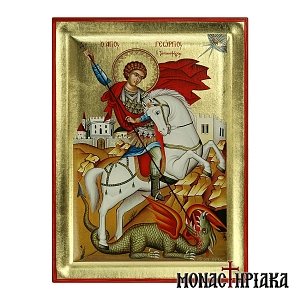The location and the founder of the Holy Monastery of Xenophon
The Holy Monastery of Xenophon is built on the western coast of the Athos peninsula and is located between the Holy Monasteries of Dochiari and Saint Panteleimon. The history of the monastery is ancient and goes back to the 10th and 11th centuries.
The founder of the Monastery is Saint Xenophon, who founded the monastery in 998 AD. and served as abbot.
In the Third charter or Typikon, the Holy Monastery of Xenophon was in eighth place, while today the monastery's hierarchical position is the sixteenth. The Xenophon Monastery is dedicated to the Holy Great Martyr George the Trophy Bearer.

The monk Simeon and the conflict in the monastery
Adventures were not missing from the life of the Holy Monastery of Xenophon, already from the time of its establishment.
An incident that disturbed the smooth course of the Monastery is the conflict that arose at the end of the 11th century with the worldly eunuch Stephan - and later monk Symeon - the drungarian of the emperor Nikephoros Botaneiatis.
Initially, Stephan's entry into the order of monks favored the Monastery by providing money which resulted in the construction of building facilities. In fact, the monk Simeon is considered the second founder of the Xenophon Monastery, as he transformed it from a small and insignificant monastery into a rich and powerful monastery. He fortified the monastery with great walls, built cells, increased the property and brought important icons and utensils to the Monastery.
Afterwards, however, his course as abbot of the Monastery brought him into conflict with the majority of the monks, resulting in his removal from the monastery. Then, Simeon asked for help and support from the emperor Alexios Comnenus and finally returned to the monastery with the order of the emperor.
The Holy Monastery of Xenophon over the centuries: brief history of the monastery
Pirate attacks against the Monastery of Xenophon
In addition to internal episodes, there are also those related to external causes. The fact that the Monastery of Xenophon is located on the coast of the Athonian Peninsula has been the reason many times for it to become the target of pirate raids. In the 13th century, the Xenophon Monastery was almost completely destroyed by Latin pirates.
In the 14th century, Monastery of Xenophon was given the title "Royal" and was registered with a golden seal of the Byzantine emperors, Andronikos II Palaiologos (1322) and Stephan Dusan (1352).

Officials and rulers of Wallachia significantly support the Monastery, so at the end of the 15th century and after, a major reconstruction takes place, the west side, the Church and the refectory (trapeza) are built.
During the 16th century the majority of the monks were Slavs and the Monastery had a relatively stable course. In the 17th century, Monastery of Xenophon was found to owe exorbitant amounts, resulting in its financial impoverishment within a general atmosphere of decline observed at that time in Athos. During that period, Romanian rulers financially supported the Monastery, offering estates and heirlooms.
In the 18th century, the Monastery of Xenophon experienced a very difficult period after multiple arbitrariness and encroachments by the Ottoman authorities. The extraordinary imposition of taxes and excessive borrowing weaken the Monastery, as a result of which it is in danger of bankruptcy.
In 1784 the Monastery, led by the hieromonk Paisios, was reorganized, with the first concern being the return to the communal system.
The Greek War of Independence of 1821 and the period of Turkish rule
Abbot Paisios from Lesvos island added new buildings and revived the Monastery. Then began the construction of the new, large Church to the north of the monastery, which was completed after the start of the Greek War of Independence of 1821.
During the period of the Turkish occupation, the Holy Monastery of Xenophon was supported either by wealthy believers, of Vlach origin, or by the annuities that came from the Skete "Rombas" and two villages that had been donated to it by Romanian rulers.

The decline and the new glorious period of the Holy Monastery of Xenophon
At the beginning of the 20th century, the Monastery experienced difficulties again, as economic and administrative instability continued. In addition, the Monastery loses a large part of its real estate in Halkidiki and Thessaloniki.
Within the wider climate of decline, the Xenophon Monastery is also threatened by decrepitude, due to the aging of the population that has affected the Athonian Peninsula in general.
However, in October 1976, Holy Monastery of Xenophon comes back to life. Archimandrite Alexios and the new brotherhood from the Monastery of the Great Meteor give new life to the Monastery and set a bright and prosperous path. During this time, the Museum of the Monastery was also inaugurated, the first to be created on Mount Athos.
The Church of the Holy Monastery of Xenophon
On the south side of the Monastery is the old Catholic, decorated with early Christian symbols. The construction of the Church dates back to the 11th century, although it went through several phases with successive additions, such as the 17th century wooden iconostasis and the painted frescoes. In 1864 the bell tower was built and in 1901 the phiale (=wellspring) of Holy Water was placed.

The relics, manuscripts and miraculous icons found in the Holy Monastery of Xenophon
The monastery has about 600 manuscripts and about 7,000 printed books. Exceptional works of art are two icons from the 14th century, Saints George and Demetrius and the well-know
miraculous icon of Panagia Hodegetria (=Guide).
The relics of the monastery include part of the Holy Wood, precious reliquaries with relics of saints, church utensils and vestments. Among the many relics of saints, the most important is perhaps the right hand of the patron of the Monastery, Saint George the Great Martyr.
Here you can find all the images with Saint George.
![]()
The Holy Monastery of Xenophon has 11 chapels, 6 chapels and has as accessories the Skete of the Annunciation of the Theotokos with 22 Huts, which is unfortunately declining due to lack of monks.
Panagia Hodegetria: the miraculous icon of Xenophon Monastery
The miraculous icon was for many years in the Church of the Holy Great Monastery of Vatopedi. In 1730, however, it suddenly disappeared from its position and was found in the Monastery of Xenophontos. The Vatopedians were persuaded of the miracle and decided not to resist to the will of the Theotokos. Here you can find all the icons with the miraculous icon of Panagia Hodegetria.

Contact with Xenophon Monastery:
Phone: +30 2377 0 23249




















